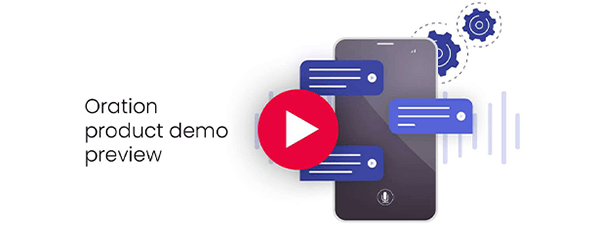We know that consumers are increasingly choosing to interact with customer services in different ways, with engagement methods such as live chat and SMS increasing in popularity. In fact, it’s estimated that by 2024, there will be 8.4 billion digital voice assistants globally. So, are businesses delivering the dynamic IVR experiences their callers expect? Let’s address the facts.
A study into contact centre satisfaction found that 76% of consumers would choose the traditional method of making a voice call to reach out to customer services. However, another study shows that typical experiences on the phone are not without their frustrations and sticking points.
In a survey of people who had used the phone to contact a business at least three times in six months, 72% said they always or frequently end up speaking to an agent after attempting to navigate the IVR menu. Even more interesting is the fact that the majority of people (69%) said listening to irrelevant phone menu options was one of their top three biggest annoyances with IVR systems.
Implementing a dynamic IVR system in your contact centre promises to improve your customer experience management processes by presenting them with a point of contact that is intelligent, intuitive, and reactive to individual needs.

What are the core components of a dynamic IVR?
Traditional IVR systems take a one size fits all approach to handling calls, essentially forcing customers to categorise their call according to the most common call types often put across in the internal business terms rather than related to the customer problem. The dynamic IVR however, is led by the caller's individual needs and identity. Using sophisticated AI technology, dynamic IVR solutions such as Convai’s cloud-based call routing software, Oration, can adapt call flows based on the information or context provided by callers.
AI-powered speech recognition. A key way that a dynamic IVR solution like Oration provides a more personalised customer experience is through its capability to recognise the caller’s intent from their natural language responses. Starting with a simple question of “How can we help you today?”, the caller is able to speak freely about their reason for making the call before the dynamic IVR uses AI-powered language interpreter technology to analyse what has been said and determine the best call routing options.
A dynamic IVR system that uses speech recognition technology eliminates the common frustrations and limitations of traditional numerical or closed option menu-based systems. Natural language understanding allows callers to interact and navigate through intuitive, targeted and potentially limitless menus using their own voice commands and responses. Unsurprisingly, the outcome of this more human-like interaction is that customers always reach the right outcome in the fastest time.
Caller identification. A dynamic IVR solution might immediately identify customers by using their phone number or location to match them with a specific customer type, query type, or existing account. This information alone could be used by the dynamic IVR to determine the best call flow options for the individual caller, or even match them to the most appropriate agent or department to handle their call based on previous interaction history or agent expertise. Imagine a scenario where a customer is calling for the second time about delivery delays; a dynamic IVR system will have the capability to recognise this previous history and after only a single open question which is used to check they really are calling about the same issue, it can provide the caller with upfront options related to delivery issues or the product they have ordered. It is really important to retain an open question - “how can I help you?” - even if you think you can predict the caller's intent. There is nothing worse than a predicted dialogue that is wrong.
Integrating the omnichannel experience. Dynamic IVR systems also recognise that customers often choose to engage with businesses through multiple channels, depending on what is most convenient at the time. Around 89% of consumers these days expect an omnichannel experience. For example, while a customer may choose to use live chat to discuss an issue in relation to a product or service, the same customer might contact the contact centre by phone later to discuss more complex queries. In this scenario, a dynamic IVR that uses omnichannel integration technology will identify previous interactions across different channels to adapt the IVR menu and provide agents with useful information and context around the call.
Ongoing supervised learning. Learning features are also critical to maintaining the continued accuracy and performance of dynamic IVR systems equipped with speech recognition technology. In the case of Oration, contact centre managers can view caller responses and suggested caller intents, so they can ensure they are appropriately matched and lead to the right call routing outcome. The IVR system then uses this input to inform and evolve its decision-making processes moving forward. Contact centre professionals can also add unusual words and phrases to help the system recognise caller intents.
By offering a more human-like interaction that understands natural speech and automatically provides intuitive responses and resolutions, a dynamic IVR is expected to be a real game-changer for almost three-quarters of consumers who say they always end up speaking with a real agent.

Advantages of implementing a dynamic IVR
-
Uses automation to increase efficiency and reduce operational costs
If there is one thing that dynamic IVR systems do well, it's balancing the need to deliver a seamless human-like customer experience with the operational benefit of saving agents time on the phone. Of course, the more time your agents spend on the phone handling queries, the more it will cost to run your contact centre operation.
A dynamic IVR solution that automatically understands the reason for making a call and can provide a potentially limitless number of automated resolutions such as targeted banners and self-service options will therefore decrease the number of agents required to handle calls. Dynamic IVR systems can also boost the efficiency of agents handling calls by identifying and transcribing key data and information provided by customers and sending to agents’ screens before they pick up the call. Integration with other channels and business applications such as CRM will also enable agents to quickly access and view information to gain the type of context that might speed up resolutions. -
Improves customer satisfaction
Imagine a scenario where a customer has tried to make their query fit within one of a list of menu options, but then discovers their time spent navigating the IVR system has been a waste because they’ve reached the wrong agent or department. And then they are put back in the call queue. This type of poor customer experience, especially when replicated across many customers, is almost certainly going to have a negative impact on your overall customer satisfaction ratings.
On the other hand, a dynamic IVR system that allows customers to speak naturally and understands their intent, so they can route calls to the right outcome the first time, will almost certainly drive-up customer satisfaction scores. -
Eliminates repetition
With traditional IVR solutions, customers can very often find themselves repeating their queries several times over. For example, if the customer has previously used live agent chat and there is no integration between different communication channels, then the customer will find themselves starting from scratch should they choose to pick up the phone. Similarly, under traditional IVR systems, customers often find themselves repeating information or reauthenticating themselves when they are passed between different agents or departments.
With a fully integrated dynamic IVR system, any information the customer has provided at any stage in their customer journey, regardless of which channel they have used, will be available to each agent handling the call. Importantly, where authentication is required, the caller will not be required to repeat the authentication steps for each agent. -
Streamlining the customer journey
Simply, a dynamic IVR system will reduce the amount of time customers spend within the IVR because they will find the answers or get the resolution they need in fewer steps and much more quickly. Aside from being able to reach the right agent first time, customers also feel more empowered and in control when they have quick access to a range of self-service options, such as checking account balances, tracking deliveries, and being directed to important information online.
With more customers able to help themselves while information automatically gathered by the IVR helps to lower average handling times, call waiting times are also reduced for customers with more complex queries. All these factors which speed up the time it takes for customers to get the help they need are likely to increase engagement and optimise sales and revenue.

Summary
On the surface, research suggests customers have conflicting priorities when it comes to how they engage with customer services. While most customers today still prefer to use the phone, impersonalised and restrictive traditional IVR systems are one of the biggest sources of frustration and dissatisfaction. Implementing a dynamic IVR system is a great way to bridge the gap between customer expectations and the operational realities of running an efficient contact centre.







